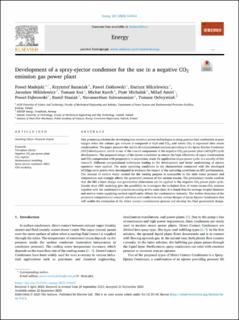| dc.contributor.author | Madejski, Pawel | |
| dc.contributor.author | Banasiak, Krzysztof | |
| dc.contributor.author | Ziolkowski, Pawel | |
| dc.contributor.author | Mikielewicz, Dariusz | |
| dc.contributor.author | Mikielewicz, Jaroslaw | |
| dc.contributor.author | Kus, Thomas | |
| dc.contributor.author | KARCH, Michal | |
| dc.contributor.author | Michalak, Piotr | |
| dc.contributor.author | Amiri, Milad | |
| dc.contributor.author | Dabrowski, Pawel | |
| dc.contributor.author | Stasiak, Kamil | |
| dc.contributor.author | Subramanian, Navaneethan | |
| dc.contributor.author | Ochrymiuk, Tomasz | |
| dc.date.accessioned | 2023-11-20T12:01:49Z | |
| dc.date.available | 2023-11-20T12:01:49Z | |
| dc.date.created | 2023-10-11T13:53:21Z | |
| dc.date.issued | 2023 | |
| dc.identifier.issn | 0360-5442 | |
| dc.identifier.uri | https://hdl.handle.net/11250/3103559 | |
| dc.description.abstract | One promising solution for developing low-emission power technologies is using gaseous fuel combustion in pure oxygen when the exhaust gas mixture is composed of H2O and CO2, and where CO2 is separated after steam condensation. The paper presents the results of computational analyses providing to the Spray-Ejector Condenser (SEC) development, which is one of the crucial components of the negative CO2 gas power plant (nCO2PP) cycle development. The proposed design of the ejector-condenser to ensure the high effectivity of vapor condensation and CO2 compression with preparation to separation, ready for application in gas power cycle, is a novelty of this research. Different computational techniques leading to the development and better understating of ejector operation were applied. The main operating conditions in the characteristic connected with the developed nCO2pp cycle points were investigated to evaluate the impact of the operating conditions on SEC performances. The amount of motive water needed for the cooling purpose is susceptible to the inlet water pressure and temperature and strongly affects the generated pressure of the suction stream. The preliminary results confirm that the SEC's basic design and geometrical dimensions can be applied in the negative CO2 power plant cycle. Results from CFD modeling give the possibility to investigate the turbulent flow of water/steam/CO2 mixture together with the condensation process occurring at this same time. It is found that the average droplet diameter and motive water supplying method significantly effects the condensation intensity. The further direction of the presented computational research activities and results is to test various designs of Spray-Ejector Condensers that will enable the evaluation of the direct contact condensation process and develop the final geometrical design. © 2023 The Authors | en_US |
| dc.description.abstract | Development of a spray-ejector condenser for the use in a negative CO2 emission gas power plant | en_US |
| dc.language.iso | eng | en_US |
| dc.publisher | Elsevier | en_US |
| dc.rights | Navngivelse-Ikkekommersiell 4.0 Internasjonal | * |
| dc.rights.uri | http://creativecommons.org/licenses/by-nc/4.0/deed.no | * |
| dc.title | Development of a spray-ejector condenser for the use in a negative CO2 emission gas power plant | en_US |
| dc.title.alternative | Development of a spray-ejector condenser for the use in a negative CO2 emission gas power plant | en_US |
| dc.type | Peer reviewed | en_US |
| dc.type | Journal article | en_US |
| dc.description.version | publishedVersion | en_US |
| dc.rights.holder | The Authors | en_US |
| dc.source.volume | 283 | en_US |
| dc.source.journal | Energy | en_US |
| dc.identifier.doi | 10.1016/j.energy.2023.129163 | |
| dc.identifier.cristin | 2183770 | |
| dc.source.articlenumber | 129163 | en_US |
| cristin.ispublished | true | |
| cristin.fulltext | original | |
| cristin.qualitycode | 2 | |

